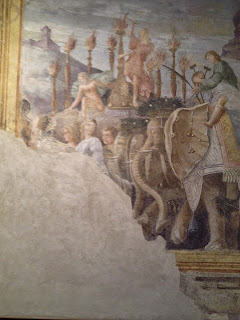In the last article we posted this week, we were in Mantua, visiting the Basilica of Sant Andrea, where we came upon a simple marble slab on the floor of the side chapel, where Andrea Mantegna is buried. Who was Mantegna?
The Gonzaga family made a forgotten Roman village into a rich and powerful duchy. Andrea Mantegna with his paintbrush, converted fortresses into palaces.
Tomb of Andrea Mantegna with his masterpiece
in the background, depiction the Infants Christ,
John the Baptist, Elizabeth and the Blessed Virgin.
The house of Andrea Mantegna in Mantua.
The triumphs of Caesar, a series of Frescos,
Palazzo San Sabastiano, Mantua, Italy
Another fresco of the series of the Triumphs of Caesar
The Ensign bearers in the Triumphs of Caesar
The Spoils of Wars in the Triumphs of Caesar,
the treasures of goldsmiths and trophies.
Occasio y Penitencia,
School of Mantegna
When I was at the Palazzo San Sabastiano in Mantua, I asked one of the security guards, "this is where I can find most of the masterpieces of Mantegna?" He replied: "Thank God most of Mantegna's work here were frescos. Otherwise the English, the French and the Americans would have taken all his works from us." There was no bitterness in his answer and nor any antagonism, just a heavy dosses of typically Italian fatalistic sarcasm, in that matter-of-fact tone that makes them enchanting.
Christ dead, after the Crucifixión,
Masterpiece of Mantegna, Brera Museum, Milan
Mantegna wasn't born in Mantua. He was the son of a carpenter. Somehow, he found himself very young, as an apprentice of one of the strangest personalities in the history of Art in Italy during the quattrocento, Squarcione. Squarcione was a successful dressmaker and tailor in Padua, with rich patrons. Squarcione invested his profits in buying small lots of lands in urban Padua. When he started clearing the land, he discovered many busts and sculptural pieces, as Padua was a major important roman city. He started a collection, and showed it to his patrons. He became one of the first major art dealers in his time, with clients throughout Italy and many parts of Europe, as far away as Greece. He started painting and established an art school, trying to bring back the customs of the classic age.
Mantegna was Squarciones most prominent student.










No comments:
Post a Comment